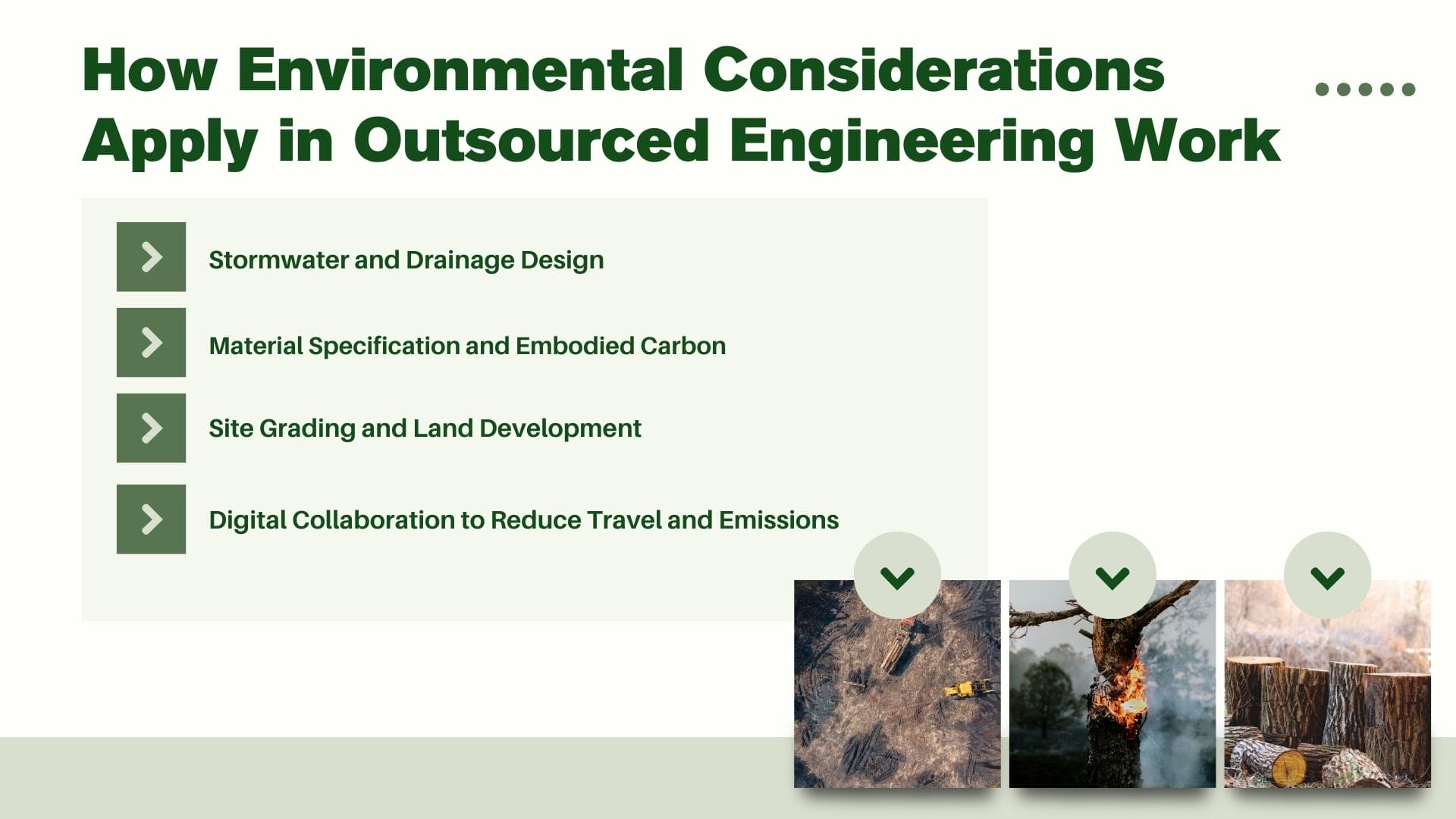In today’s era of sustainable development, outsourcing is no longer just about cost savings and operational efficiency. For civil engineering firms, especially those working on large-scale infrastructure or land development projects, outsourcing must also account for its environmental impact. At AXA Engineers, we understand that sustainability isn’t a trend – it’s a responsibility. That’s why we actively consider environmental factors in every outsourced engineering solution we deliver.
From design principles to material choices and project coordination, civil engineering outsourcing can play a significant role in reducing the environmental footprint of construction projects. In this article, we’ll explore what environmental considerations mean, how they apply in outsourced civil engineering work, and how we integrate sustainable practices into our workflows at AXA Engineers.
What Is “Environmental Considerations” in Civil Engineering?
Before examining outsourcing specifics, it’s essential to define the scope of environmental considerations in civil engineering. This term encompasses a broad range of factors related to minimizing negative impacts and maximizing positive contributions to the natural world throughout a project’s lifecycle – from initial concept and design through construction, operation, and eventual decommissioning. Key components include:
-
Resource Management: Evaluating the consumption of natural resources like water, aggregates, timber, and energy. This includes specifying sustainable or recycled materials and designing for energy and water efficiency during the project’s operational phase.
-
Pollution Prevention: Mitigating potential contamination of air (e.g., dust, emissions), water (e.g., stormwater runoff, chemical spills), and soil. Noise pollution during construction and operation is also a significant factor.
-
Waste Reduction and Management: Minimizing the generation of construction and demolition (C&D) waste through efficient design and material use, promoting recycling and reuse, and ensuring proper disposal of all waste streams, including potentially hazardous materials.
-
Biodiversity and Habitat Protection: Assessing impacts on local ecosystems, flora, and fauna. This involves avoiding sensitive areas where possible, minimizing habitat fragmentation, protecting endangered species, and potentially implementing habitat restoration or enhancement measures.
-
Land Use and Soil Conservation: Considering the impact of site development on land resources, minimizing unnecessary disturbance, preventing soil erosion through effective control measures, and preserving valuable topsoil.
-
Climate Change Mitigation and Adaptation: Analyzing the project’s carbon footprint, including embodied carbon in materials (a major contributor, according to industry bodies like the World Green Building Council) and operational emissions. It also involves designing infrastructure resilient to the anticipated impacts of climate change, such as sea-level rise, extreme weather events, or water scarcity.

How Environmental Considerations Apply in Outsourced Engineering Work
Stormwater and Drainage Design
One of the most critical aspects of environmental design in civil engineering is stormwater and drainage planning, involving critical environmental considerations. Poorly designed systems can lead to soil erosion, flooding, and the contamination of local water bodies.
Low Impact Development (LID) strategies are now common in modern stormwater design services, representing key environmental considerations. These include bioswales, permeable pavements, and retention basins that mimic natural water flow. By following EPA guidelines and jurisdictional stormwater regulations, engineers can ensure designs address these environmental considerations, supporting water quality, reducing peak runoff, and enhancing infiltration.
According to the Environmental Protection Agency (EPA), stormwater management strategies that incorporate LID principles can reduce runoff pollution by up to 70% (EPA, 2023), highlighting the effectiveness of addressing these specific environmental considerations.
Material Specification and Embodied Carbon
Material selection brings critical environmental considerations to the forefront, particularly concerning the environmental impact of materials used in construction. Traditional materials such as Portland cement and steel contribute heavily to greenhouse gas emissions due to their energy-intensive production processes. When outsourced engineering teams select these materials without adequate environmental considerations, the carbon footprint of the project can rise significantly.
Sustainable teams prioritize materials addressing key environmental considerations. This includes reviewing Environmental Product Declarations (EPDs) and conducting lifecycle assessments to understand long-term environmental effects. Alternative materials such as fly ash-blended concrete or recycled steel are often recommended, especially for clients aiming for LEED or similar green building certifications where material-related environmental considerations are heavily weighted.
Site Grading and Land Development
Site grading is another outsourced task that can have significant environmental consequences. Grading that excessively alters natural land contours can damage ecosystems, increase surface runoff, and destroy native vegetation.
Using advanced tools such as Civil 3D and GIS integration allows teams to capture accurate site data and plan grading that respects the land’s natural topography. These digital tools are essential for informed, sustainable design decisions. This approach helps minimize earth movement and protects existing soil structures, leading to lower erosion risks and healthier landscapes. Whenever possible, preserving trees and native plants maintains the site’s ecological integrity.
Digital Collaboration to Reduce Travel and Emissions
Beyond design choices, the outsourcing process itself offers environmental benefits—particularly in reducing the need for carbon-intensive travel. Traditional project management might involve frequent site visits, cross-country flights, and in-person coordination. Outsourcing—when done right—can significantly cut these emissions.
Cloud-based platforms such as BIM 360, Microsoft Teams, and OneDrive facilitate real-time communication with clients across the globe. This virtual-first workflow allows teams to collaborate effectively without relying on carbon-intensive travel.
A McKinsey report from 2022 highlights that engineering firms using remote collaboration tools can cut their business travel-related emissions by up to 30%.

Read more our articles:
- How Can Outsourcing Help in Scaling Up Civil Engineering Projects?
- 7 Future Trends in Civil Engineering 2025 and How Outsourcing Can Help
- How To Turn Time Zone Challenges Into Advantages In Outsourcing
Environmental Regulations and Compliance in Outsourcing
Compliance with environmental regulations is a non-negotiable aspect of civil engineering. Outsourcing does not change this requirement—in fact, it introduces new layers of complexity, especially when crossing regional or national boundaries.
Regulatory research should be a core part of onboarding for any new project. Teams must be familiar with environmental codes from the Clean Water Act (U.S.) to regional planning requirements in Australia, Canada, and Southeast Asia.
Providing clients with the necessary documentation—such as erosion and sediment control plans (ESCPs), detention and retention system calculations, and BMP (Best Management Practice) reports—is essential to maintain compliance and avoid costly delays or fines.
How AXA Engineers Leads in Sustainable Outsourcing
We believe environmental responsibility and engineering efficiency should go hand in hand. Our team integrates sustainable principles at every step of the outsourcing process.
Our 60+ engineers bring deep expertise in areas such as stormwater design, erosion control, and sustainable material selection. Each project undergoes a rigorous QA/QC process that includes environmental performance checks. We collaborate closely with our clients to understand their sustainability priorities and reflect those in every drawing, specification, and report.
Technology plays a central role in our sustainable strategy. By maintaining a fully digital workflow, we reduce design revisions, and ensure quicker adaptation to environmental changes during construction.
Successful Civil Outsourcing Project: The Robertson Development Project
Environmental considerations in civil engineering outsourcing aren’t optional—they’re essential. As firms look for ways to stay competitive and sustainable, the right outsourcing partner can make a critical difference.
Every outsourced plan should carry the same commitment to sustainability as if it were built in-house. Whether your project involves site grading, drainage planning, or permitting support, choosing a partner aligned with your environmental goals ensures a responsible path forward.




